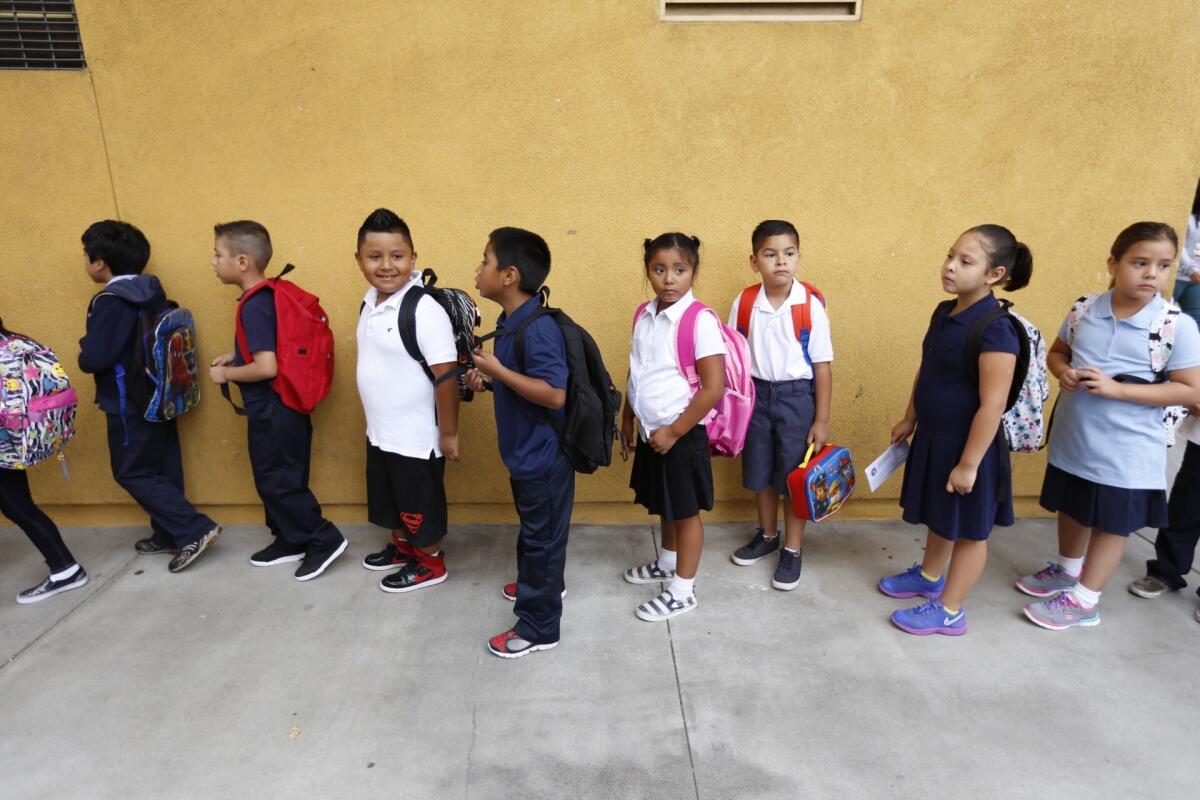Lottery won’t be a big win for California schools; never has, never will

First-grade students at Vine Street Elementary School in Hollywood.
Reporting From Sacramento — Year after year, the voters in political consultant Gale Kaufman’s focus groups have gathered to talk about education funding in California.
And every time, within minutes, the group seems to zero in on the lottery.
“We used to have a bet,” said Kaufman of her staffers, “about how long it would take before someone said: ‘What about the lottery? Wasn’t that supposed to raise enough money to fund the schools?’”
Kaufman, the veteran campaign strategist for the California Teachers Assn., said that few political narratives in the Golden State are more steady, or stubborn, as the assumption that the state’s 31-year-old lottery has been a budget bonanza for schools.
In reality, it’s little more than the equivalent of loose change.
While the numbers fluctuate slightly, over time the California Lottery has provided slightly less than 2 cents of every dollar in what’s spent to operate K-12 schools.
In fact, two pennies of every dollar is the high-water mark. Data compiled by the independent legislative analyst’s office shows that for most of the past decade, the lottery has been closer to 1% of school funding. In the 2016-17 budget proposed by Gov. Jerry Brown last week, K-12 education is slated to receive a total of $86.5 billion from all sources; the lottery’s share is about $1.1 billion.
The reason is pretty simple. In order to entice Californians to buy a ticket, most of the cash has to go to the lucky ticket holders as the jackpot.
“It’s a fine line,” said Alex Traverso, a spokesman for the California Lottery.
Lottery rules require 50 percent of ticket sales in Mega Millions and Powerball to go to the jackpot. Forty percent goes to K-12 education, with the remaining share covering the operations of the game and the lottery system.
But the biggest revenue generator has been the instant winner Scratchers games, accounting for almost three-quarters of the California Lottery’s $5.5-billion in sales for the most recent fiscal year. And Scratchers aren’t subject to the same rules; almost 80% of ticket sales go to prizes. Legislators and former Gov. Arnold Schwarzenegger placed new limits on administrative costs when they expanded the Scratchers game in 2010, but the booming sales haven’t really moved the needle on the total payout for schools.
“The amount of money you have to pay in prizes is significant,” said Traverso of the instant-winning games.
No one in political circles seems to know for sure why voters have latched on to the idea of the lottery as the savior of schools. But the original sales pitch, found in the ballot arguments for the initiative that authorized California’s lottery, offers a hint.
“Lotteries in other states provide a stable and growing source of income,” wrote backers from local and state school groups in the 1984 ballot guide. “The lottery won’t solve all of education’s financial problems. But it will be a big help!”
Not surprisingly, opponents said just the opposite. “Neither schools nor the public will get rich from this scheme,” wrote lottery opponents including former Atty. Gen. John Van de Kamp. “In successive years, just as now, increased educational funding will continue to be the responsibility of the Legislature and the governor.”
It wasn’t the last time that voters took action to improve school funding. Four years later, in 1988, they created a set of mandatory spending formulas that have come to dominate the annual crafting of a state budget. The lottery, by comparison, was tinkering around the edges.
See more of our top stories on Facebook >>
That’s not to say its dollars aren’t welcome by local schools. One reason why education officials like lottery subsidies is that they’re almost completely discretionary dollars. In other words, school districts can use them most any way they want -- unlike the complex rules placed on dollars that come from state, federal, and local taxes.
Wednesday night’s Powerball drawing, whether it produces a winner or not, has pretty good odds of being the biggest single source of next year’s payment to schools. But it could also fuel the dreams of aspiring billionaires that they’re coming to the rescue of schoolchildren across California.
In fact, the misconception about the lottery and education funding may play a role in shaping the 2016 campaign by Democrats, labor, and healthcare groups to help schools and other services by extending soon-to-expire income tax rates on the most wealthy.
“It’s a hurdle,” said Kaufman of the lingering lottery belief. “While voters seem to not remember too many other things, for some reason they remember that.”
Follow @johnmyers on Twitter and sign up for our daily Essential Politics newsletter
MORE ON POWERBALL
Here’s $100. Can you win $1.5 billion at Powerball?
Powerball jackpot still rising, reaches $1.5 billion
How the Powerball rules were tweaked to make the game an even bigger ripoff
More to Read
Get the L.A. Times Politics newsletter
Deeply reported insights into legislation, politics and policy from Sacramento, Washington and beyond. In your inbox three times per week.
You may occasionally receive promotional content from the Los Angeles Times.











